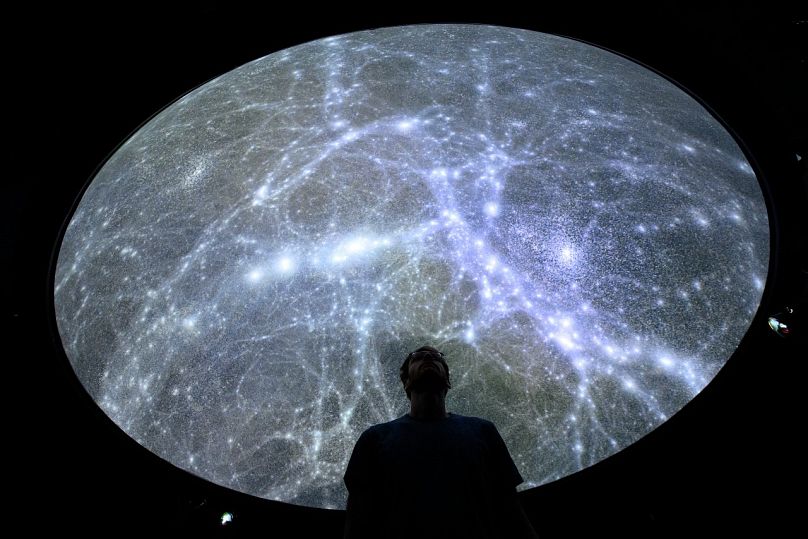Have you ever wanted to explore outer space without leaving the Earth? This VR software is your ticket to the furthest reaches of the galaxy.
Picture this: you’re floating in space and looking at the Earth. On your right, you can see the International Space Station - currently home to French astronaut Thomas Pesquet and his colleagues - in orbit.
On your left, the moon and the vast immensity of the universe extends into the distance.
No, it’s not a dream. This is the beginning of a journey into outer space, thanks to a programme developed by researchers at one of Switzerland’s top universities: the VIRUP software.
How to visualise the universe at different scales?
The Virtual Reality Universe Project (VIRUP) is open-source beta software that allows for virtual visits through the cosmos.
It’s the result of several types of research, conducted by software engineers, astrophysicists and experimental museology experts at the École Polytechnique Fédérale de Lausanne (EPFL), in Switzerland.
They have pulled together what they call the largest data set of the universe to create three-dimensional, panoramic visualisations of space.
In short, their 3D model is a sort of Google Earth but for the universe.
“So what we see here is a representation of the universe that has been obtained thanks to gigantic numerical consignation,” astrophysicist Yves Revaz explained.
“In fact, thanks to computers, we are able to reproduce the evolution over a long period of time of a portion of the universe that lets us understand how the matter is distributed all around the universe”.
The virtual map can be viewed through individual VR gear, immersion systems like panoramic cinemas with 3D glasses, dome screens, or just on a PC for two-dimensional viewing.
The images produced by the algorithms can appear as close as 1 m, or almost infinitely far away.
The multi-sensorial experiment project has two stated goals: to be able to visualise the universe at different scales and to draw in a broad array of visitors, from scientists to amateurs.
Shine bright like tens of terabytes of data
Astronomers and astrophysicists have been collecting data on billions of celestial objects for decades with telescopes on Earth and in space.
In order to get visual representations of tens of terabytes of data sets, Revaz and software engineer Florian Cabot rendered the data at 90 frames per second, like a movie.
“Visualisation of astrophysical data is much more accessible than showing graphs and figures, it helps to develop an intuition of complex phenomena,” Revaz said.
“VIRUP is precisely a way of making all of our astrophysical data accessible to everyone, and this will become even more important as we build bigger telescopes like the Square Kilometer Array that will generate tremendous amounts of data”.
The project can visualise data from eight databases bundled together, among which is the Sloan Digital Sky survey, which consists of over 50 million galaxies and 300 million objects in general.
It also based its research on data from the Open Exoplanet Catalog, which aggregates various sources of exoplanet data.
The biggest challenge VIRUP has to overcome is linked to its storage capacity: still a work in progress for now, the beta version can't be run on a Mac — and it needs a lot of internal storage to work on a PC.
A tool for other industries?
According to Jean-Paul Kneib, director of the Laboratory of Astrophysics of EPFL, this educational visualisation model could be applied to other industries.
"If we want to look inside our brain, if we want to go and look at what is happening in the Tokamaks for fusion. We have developed a 3D visualisation tool that can really be beneficial to many scientific fields," said Kneib.
Even though VR games and universe representations already exist, the EPFL team says VIRUP goes much further and wider since it brings together these vast data sets containing hundreds of millions of space objects in a “one-stop-shop solution”.
“In fact, we actually started this project because I was working on a three-dimensional mapping project of the universe and was always a little frustrated with the 2D visualisation on my screen, which wasn't very meaningful, “ Kneib told AFP.
“And the idea is to say no, it's not just 2D, we'll make a map in 3D - let's see it in 3D, we're not going to simplify complex things. It's true that by showing the universe in 3D, by showing these filaments, by showing these clusters of galaxies which are large concentrations of matter, you really realise what the universe is,” he added.












